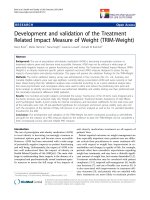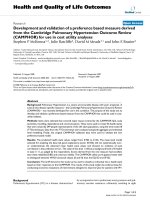báo cáo hóa học:" Existence and multiplicity of solutions for a fourth-order elliptic equation" potx
Bạn đang xem bản rút gọn của tài liệu. Xem và tải ngay bản đầy đủ của tài liệu tại đây (207.93 KB, 18 trang )
This Provisional PDF corresponds to the article as it appeared upon acceptance. Fully formatted
PDF and full text (HTML) versions will be made available soon.
Existence and multiplicity of solutions for a fourth-order elliptic equation
Boundary Value Problems 2012, 2012:6 doi:10.1186/1687-2770-2012-6
Fanglei Wang ()
Yukun An ()
ISSN 1687-2770
Article type Research
Submission date 26 August 2011
Acceptance date 17 January 2012
Publication date 17 January 2012
Article URL />This peer-reviewed article was published immediately upon acceptance. It can be downloaded,
printed and distributed freely for any purposes (see copyright notice below).
For information about publishing your research in Boundary Value Problems go to
/>For information about other SpringerOpen publications go to
Boundary Value Problems
© 2012 Wang and An ; licensee Springer.
This is an open access article distributed under the terms of the Creative Commons Attribution License ( />which permits unrestricted use, distribution, and reproduction in any medium, provided the original work is properly cited.
Existence and multiplicity of solutions for
a fourth-order elliptic equation
Fanglei Wang
∗1
and Yukun An
2
1
College of Science, Hohai University, Nanjing, 210098, P. R. China
2
Department of Mathematics, Nanjing University of Aeronautics and Astronautics,
Nanjing 210016, P. R. China
∗
Corresponding author:
Email address:
YA:
Abstract
This article is concerned with the existence and multiplicity of nontrival solutions
for a fourth-order elliptic equation
∆
2
u − M
Ω
|∇u|
2
dx
∆u = f (x, u), inΩ,
u = ∆u = 0, on ∂Ω
by using the mountain pass theorem.
Keywords: fourth-order elliptic equation; nontrivial solutions; mountain pass theo-
rem.
1
1 Introduction
In this article we study the existence of nontrivial solutions for the fourth-order
boundary value problem
∆
2
u − M
Ω
|∇u|
2
dx
∆u = f(x, u), in Ω,
u = ∆u = 0, on ∂Ω,
(1)
where Ω ⊂ R
N
is a bounded smooth domain, f : Ω × R → R and M : R → R are
continuous functions. The existence and multiplicity results for Equation (1) are
considered in [1–3] by using variational methods and fixed point theorems in cones
of ordered Banach space with space dimension is one.
On the other hand, The four-order semilinear elliptic problem
∆
2
u + c∆u = f(x, u), in Ω,
u = ∆u = 0, on ∂Ω,
(2)
arises in the study of traveling waves in a suspension bridge, or the study of the
static deflection of an elastic plate in a fluid, and has been studied by many authors,
see [4–10] and the references therein.
Inspired by the above references, the object of this article is to study existence
and multiplicity of nontrivial solution of a fourth-order elliptic equation under some
conditions on the function M(t) and the nonlinearity. The proof is based on the
mountain pass theorem, namely,
Lemma 1.1. Let E be a real Banach space, and I ∈ C
1
(E, R) satisfy (P S)-
2
condition. Suppose
(1) There exist ρ > 0, α > 0 such that
I|
∂B
ρ
≥ I(0) + α,
where B
ρ
= {u ∈ E|u ≤ ρ}.
(2) There is an e ∈ E and e > ρ such that
I(e) ≤ I(0).
Then I(u) has a critical value c which can be characterized as
C = inf
γ∈Γ
max
u∈γ([0,1])
I(u),
where Γ = {γ ∈ C([0, 1], E)|γ(0) = 0, γ(1) = e}.
The article is organized as follows: Section 2 is devoted to giving the main result
and proving the existence of nontrivial solution of Equation (1). In Section 3, we deal
with the multiplicity results of Equation (1) whose nonlinear term is asymptotically
linear at both zero and infinity.
2 Main result I
Theorem 2.1. Assume the function M(t) and the nonlinearity f(x, t) satisfying the
following conditions:
3
(H1) M(t) is continuous and satisfies
M(t) > m
0
, ∀ t > 0, (3)
for some m
0
> 0. In addition, that there exist m
> m
0
and t
0
> 0, such that
M(t) = m
, ∀ t > t
0
. (4)
(H2) f(x, t) ∈ C(Ω × R); f(x, t) ≡ 0, ∀x ∈ Ω, t ≤ 0, f(x, t) ≥ 0, ∀x ∈ Ω, t > 0;
(H3) |f(x, t)| ≤ a(x) + b|t|
p
, ∀t ∈ R and a.e. x in Ω, where a(x) ∈ L
q
(Ω), b ∈ R
and 1 < p <
N+4
N−4
if N > 4 and 1 < p < ∞ if N ≤ 4 and
1
q
+
1
p
= 1;
(H4) f(x, t) = o(|t|) as t → 0 uniformly for x ∈ Ω ;
(H5) There exists a constant Θ > 2 and R > 0, such that
ΘF (x, s) ≤ sf(x, s), ∀ | s| ≥ R.
Then Equation (1) has at least one nonnegative solution.
Let Ω ⊂ R
N
be a bounded smooth open domain, H = H
2
(Ω)
H
1
0
(Ω) be the
Hilbert space equipped with the inner product
(u, v) =
Ω
(∆u∆v + ∇u∇v)dx,
and the deduced norm
u
2
=
Ω
|∆u|
2
dx +
Ω
|∇u|
2
dx.
4
Let λ
1
be the positive first eigenvalue of the following second eigenvalue problem
−∆v = λv, in Ω,
v = 0, on ∂Ω.
Then from [4], it is clear to see that Λ
1
= λ
1
(λ
1
− c) is the positive first eigenvalue
of the following fourth-order eigenvalue problem
∆
2
u + cu = λu, in Ω,
∆u = u = 0, on ∂Ω,
where c < λ
1
. By Poincare inequality, for all u ∈ H, we have
u
2
≥ Λ
1
u
2
L
2
. (5)
A function u ∈ H is called a weak solution of Equation (1) if
Ω
∆u∆vdx + M
Ω
|∇u|
2
dx
Ω
∇u∇vdx =
Ω
f(x, u)vdx
holds for any v ∈ H. In addition, we see that weak solutions of Equation (1) are
critical points of the functional I : H → R defined by
I(u) =
1
2
Ω
|∆u|
2
dx +
1
2
M
Ω
|∇u|
2
dx
−
Ω
F (x, u)dx,
where
M(t) =
t
0
M(s)ds and F (x, t) =
f(x, t)dt. Since M is continuous and f
has subcritical growth, the above functional is of class C
1
in H. We shall apply the
famous mountain pass theorem to show the existence of a nontrivial critical point
of functional I(u).
5
Lemma 2.2. Assume that (H1)–(H5) hold, then I(u) satisfies the (PS)-condition.
Proof. Let {u
n
} ⊂ H be a (PS )-sequence. In particular, {u
n
} satisfies
I(u
n
) → C, and I
(u
n
), u
n
→ 0 as n → ∞. (6)
Since f(x, t) is sub-critical by (H3), from the compactness of Sobolev embedding
and, following the standard processes we know that to show that I verifies (P S)-
condition it is enough to prove that {u
n
} is bounded in H. By contradiction, assume
that u
n
→ +∞.
Case I. If
Ω
|∇u
n
|
2
dx is bounded,
Ω
|∆u
n
|
2
dx → +∞. We assume that there
exist a constant K > 0 such that
Ω
|∇u
n
|
2
dx ≤ K. By (H1), it is easy to obtain
that ˜m = max
t∈[0,K]
M(t) > m
0
. Set l
1
= min{1, m
0
}, l
2
= max{1, ˜m}. Then, from
6
(H1), (H3), and (H5), we have
I(u
n
) −
l
1
2l
2
I
(u
n
)u
n
=
1
2
Ω
|∆u
n
|
2
dx +
1
2
M
Ω
|∇u
n
|
2
dx
−
Ω
F (x, u
n
)dx
−
l
1
2l
2
Ω
|∆u
n
|
2
dx + M
Ω
|∇u
n
|
2
dx
Ω
|∇u
n
|
2
dx
+
l
1
2l
2
Ω
f(x, u
n
)u
n
dx
≥
1
2
l
1
u
n
2
+
Ω
l
1
2l
2
f(x, u
+
n
)u
n
− F (x, u
+
n
)
dx
≥
1
2
l
1
u
n
2
+
u
n
≥R
l
1
2l
2
f(x, u
+
n
)u
+
n
− F (x, u
+
n
)
dx − C
1
≥
1
2
l
1
u
n
2
+
l
1
2l
2
u
n
≥R
f(x, u
+
n
)u
+
n
−
2l
2
l
1
F (x, u
+
n
)
dx − C
1
≥
1
2
l
1
u
n
2
+
l
1
2l
2
u
n
≥R
f(x, u
+
n
)u
+
n
− ΘF (x, u
+
n
)
dx − C
1
.
On the other hand, it is easy to obtain that
I(u
n
) −
l
1
2l
2
I
(u
n
)u
n
≤ C + Cu
n
.
Then, from above, we can have
u
n
2
≤ C + Cu
n
,
which contradicts u
n
→ +∞. Therefore {u
n
} is bounded in H.
Case II. If
Ω
|∇u
n
|
2
dx → +∞. By (H1), let l
2
= max{1, m
}, we also can ob-
tain that {u
n
} is bounded in H.
7
This lemma is completely proved.
Lemma 2.3. Suppose that (H1)–(H5) hold, then we have
(1) there exist constants ρ > 0, α > 0 such that I|
∂B
ρ
≥ α with B
ρ
= {u ∈ H :
u ≤ ρ};
(2) I(tϕ
1
) → −∞ as t → +∞.
Proof. By (H1)–(H4), we see that for any ε > 0, there exist constants C
1
> 0, C
2
such that for all (x, s) ∈ Ω × R, one have
F (x, s) ≤
1
2
εs
2
+ C
1
s
p+1
(7)
Choosing ε > 0 small enough, we have
I(u) =
1
2
Ω
|∆u|
2
dx +
1
2
M
Ω
|∇u|
2
dx
−
Ω
F (x, u)dx
≥
1
2
Ω
|∆u|
2
dx +
1
2
m
0
Ω
|∇u|
2
dx −
Ω
F (x, u)dx
≥
1
2
l
1
u
2
−
ε
2
u
2
L
2
− C
1
u
p+1
L
p+1
≥
1
2
(l
1
− ε)u
2
− C
3
u
p+1
.
by (3), (5), (7) and the Sobolev inequality. So, part 1 is proved if we choose u =
ρ > 0 small enough.
8
On the other hand, we have
I(u) =
1
2
Ω
|∆u|
2
dx +
1
2
M
Ω
|∇u|
2
dx
−
Ω
F (x, u)dx
≤
1
2
Ω
|∆u|
2
dx +
1
2
m
1
Ω
|∇u|
2
dx −
Ω
F (x, u)dx
≤
1
2
l
2
u
2
− u
Θ
Θ
+ C
4
.
using (4) and (H5). Hence,
I(tϕ
1
) ≤
1
2
l
2
t
2
ϕ
1
2
− t
Θ
ϕ
1
Θ
Θ
+ C
4
→ −∞
as t → +∞ and part 2 is proved.
Proof of Theorem 2.1. From Lemmas 2.2 and 2.3, it is clear to see that I(u)
satisfies the hypotheses of Lemma 1.1. Therefore I(u) has a critical point.
3 Existence result II
Theorem 3.1. Assume that (H1) holds. In addition, assume the following condi-
tions are hold:
(H6) f(x, t)t ≥ 0 for x ∈ Ω, t ∈ R;
(H7) lim
t→0
f(x,t)
t
= α, lim
|t|→+∞
f(x,t)
t
= β, uniformly in a.e x ∈ Ω, where 0 ≤
α
min{1,m
0
}
< λ
1
(λ
1
+ m
) < β < +∞.
Then Equation (1) has at least two nontrivial solutions, one of which is positive and
the other is negative.
9
Let u
+
= max{u, 0}, u
−
= min{u, 0}. Consider the following problem
∆
2
u − M(
Ω
|∇u|
2
dx)∆u = f
+
(x, u), in Ω,
u = ∆u = 0, on ∂Ω,
(8)
where
f
+
(x, t) =
f(x, t), if t ≥ 0,
0, if t < 0.
Define the corresponding functional I
+
: H→ R as follows:
I
+
(u) =
1
2
Ω
|∆u|
2
dx +
1
2
M
Ω
|∇u|
2
dx
−
Ω
F
+
(x, u)dx, ∀u ∈ H,
where F
+
(x, u) =
u
0
f
+
(x, t)dt. Obviously, I
+
∈ C
1
(H, R). Let u be a critical point
of I
+
which implies that u is the weak solution of Equation (8). Futhermore, by
the weak maximum principle it follows that u ≥ 0 in Ω. Thus u is also a solution of
Equation (1).
Similarly, we also can define
f
−
(x, t) =
f(x, t), if t ≤ 0,
0, if t > 0,
and
I
−
(u) =
1
2
Ω
|∆u|
2
dx +
1
2
M
Ω
|∇u|
2
dx
−
Ω
F
−
(x, u)dx, ∀u ∈ H,
where F
−
(x, u) =
u
0
f
−
(x, t)dt. Obviously, I
−
∈ C
1
(H, R). Let u be a critical point
of I
−
which implies that u is the weak solution of Equation (1) with I
−
(u) = I(u).
10
Lemma 3.2. Assume that (H1), (H6), and (H7) hold, then I
±
satisfies the (PS)
condition.
Proof. We just prove the case of I
+
. The arguments for the case of I
−
are similar.
Since Ω is bounded and (H7) holds, then if { u
n
} is b ounded in H, by using the
Sobolve embedding and the standard procedures, we can get a convergent subse-
quence. So we need only to show that {u
n
} is bounded in H.
Let {u
n
} ⊂ H be a sequence such that
I
+
(u
n
) → c, ∇I
+
(u
n
) → 0. (9)
By (H7), it is easy to see that
|f
+
(x, s)s| ≤ C
1 + |s|
2
.
Now, (9) implies that, for all φ ∈ H, we have
Ω
∆u
n
∆φdx + M
Ω
|∇u
n
|
2
dx
Ω
∇u
n
∇φdx −
Ω
f
+
(x, u
n
)φdx → 0. (10)
Set φ = u
n
, we have
min{1, m
0
}u
n
2
≤
Ω
|∆u
n
|
2
dx + M
Ω
|∇u
n
|
2
dx
Ω
|∇u
n
|
2
dx
=
Ω
f
+
(x, u
n
)u
n
dx + ∇I
+
(u
n
), u
n
≤
Ω
f
+
(x, u
n
)u
n
dx + o(1)u
n
≤ C + Cu
n
2
L
2
+ o(1)u
n
. (11)
11
Next, we will show that u
n
2
L
2
is bounded. If not, we may assume that u
n
L
2
→
+∞ as n → +∞. Let ω
n
=
u
n
u
n
L
2
, then ω
n
L
2
= 1. From (11), we have
ω
n
2
≤ o(1) + C +
o(1)
u
n
L
2
u
n
u
n
L
2
= o(1) + C + o(1)ω
n
,
thus {ω
n
} is b ounded in H. Passing to a subsequence, we may assume that there
exists ω ∈ H with ω
L
2
= 1 such that
ω
n
ω, weakly in H, n → +∞,
ω
n
→ ω, strongly in L
2
(Ω), n → +∞.
On the other hand, u
n
L
2
→ +∞ as n → +∞, by Poincare inequality, it is easy
to know that
Ω
|∇u
n
|
2
dx → +∞ as n → +∞ . Thus by (H1), the function
M(
Ω
|∇u
n
|
2
dx) = m
as n → +∞. So as n → +∞, by (10), we have
Ω
∆ω∆φdx + m
Ω
∇ω∇φdx −
Ω
βω
+
φdx = 0, ∀φ ∈ H. (12)
Then ω ∈ H is a weak solution of the equation
∆
2
ω − m
∆ω = βω
+
.
The weak maximum principle implies that ω = ω
+
≥ 0. Choosing φ(x) = ϕ
1
(x) > 0,
which is the corresponding eigenfunctions of λ
1
. From (10), we get
Ω
∆ω∆ϕ
1
dx + m
Ω
∇ω∇ϕ
1
dx = β
Ω
ω
+
ϕ
1
dx. (13)
On the other hand, we can easily see that Λ = λ
1
(λ
1
+ m
) is the eigenvalue of the
problem
∆
2
u − m
∆u = Λu, in Ω,
∆u = u = 0, on ∂Ω
12
and the corresponding eigenfunction is still ϕ
1
(x). If ω(x) > 0, we also have
Ω
∆ω∆ϕ
1
dx + m
Ω
∇ω∇ϕ
1
dx = Λ
Ω
ω
+
ϕ
1
dx, (14)
which follows that ω ≡ 0 by Λ < β. But this conclusion contradicts ω
L
2
= 1.
Hence {u
n
} is bounded in H.
Now we prove that the functionals I
±
has a mountain pass geometry.
Lemma 3.3. Assume that (H1), (H7) hold, then we have
(1) there exists ρ, R > 0 such that I
±
(u) > R, if u = ρ;
(2) I
±
(u) are unbounded from below.
Proof. By (H7), for any ε > 0, there exists C
1
> 0, C
2
> 0 such that ∀(x, s) ∈ Ω×R,
we have
F (x, s) ≤
1
2
(α + ε)s
2
+ C
1
s
p+1
(15)
and
F (x, s) ≥
1
2
(β − ε)s
2
− C
2
, (16)
where 2 < p < 2
∗
=
2N
N−2
, N > 2,
+∞, N ≤ 2.
We just prove the case of I
+
. The arguments for the case of I
−
are similar. Let
13
φ = tϕ
1
. When t is sufficiently large, by (16) and (H1), it is easy to see that
I
+
(tϕ
1
) =
1
2
Ω
|∆(tϕ
1
)|
2
dx +
1
2
M
Ω
|∇(tϕ
1
)|
2
dx
−
Ω
F
+
(x, tϕ
1
)dx
≤
1
2
Ω
|∆(tϕ
1
)|
2
dx +
1
2
m
Ω
|∇(tϕ
1
)|
2
dx −
Ω
1
2
(β − ε)(tϕ
1
)
2
− C
2
dx
=
t
2
2
Ω
|∆ϕ
1
|
2
dx + m
Ω
|∇ϕ
1
|
2
dx − (β − ε)
Ω
ϕ
2
1
dx
+ C
2
|Ω|
=
t
2
2
[Λ − (β − )] ϕ
1
L
2
+ C
2
|Ω|
→ −∞, as t → +∞.
On the other hand, by (17), (H1), the Poincare inequality and the Sobolve embed-
ding, we have
I
+
(u) =
1
2
Ω
|∆u|
2
dx +
1
2
M
Ω
|∇u|
2
dx
−
Ω
F
+
(x, u)dx
≥
1
2
min{1, m
0
}u −
α + ε
2
Ω
|u|
2
dx − C
1
Ω
|u|
p+1
dx
≥
1
2
min{1, m
0
} −
α + ε
2Λ
u − C
4
u
p+1
,
where C
4
is a constant. Choosing u = ρ small enough, we can obtain I
+
(u) ≥
R > 0 if u = ρ.
Proof of Theorem 3.1. From Lemma 3.3, it is easy to see that there exists e ∈ H
with e > ρ such that I
±
(e) < 0.
Define
P = {γ : [0, 1] → H : γ is continuous and γ(0) = 0, γ(1) = e},
14
and
c
±
= inf
γ∈P
max
t∈[0,1]
I
±
(γ(t)).
From Lemma 3.3, we have
I
±
(0) = 0, I
±
(e) < 0, I
±
(u)|
∂B
ρ
≥ R > 0.
Moreover, by Lemma 3.2, the functions I
±
satisfies the (PS)-condition. By Lemma
1.1, we know that c
+
is a critical value of I
+
and there is at least one nontrival
critical point in H corresponding to this value. This critical in nonnegative, then
the strong maximum principle implies that is a positive solution of Equation (1).
By an analogous way we know there exists at least one negative solution, which is a
nontrivial critical point of I
−
Hence, Equation (1) admits at least a positive solution
and a negative solution.
Competing interest
The authors’ declare that they have no competing interests.
Authors’ contribution
In this manuscript the authors studied the existence and multiplicity of solutions
for an interesting fourth-order elliptic equation by using the famous mountain pass
lemma. Moreover, in this work, the authors’ supplements done in [1–3]. All authors
15
typed, read and approved the final manuscript.
Acknowledgment
The authors’ would like to thank the referees for valuable comments and suggestions
for improving this article.
References
[1] Ma, TF: Existence results for a model of nonlinear beam on elastic bearings.
Appl. Math. Lett. 13, 11–15 (2000)
[2] Ma, TF: Existence results and numerical solutions for a beam equation with
nonlinear boundary conditions. Appl. Numer. Math. 47, 189–196 (2003)
[3] Ma, TF: Positive solutions for a nonlocal fourth-order equations of Kirchhoff
type. Discrete Contin. Dyn. Syst. (suppl.), 694–703 (2007)
[4] An, Y, Liu, R: Existence of nontrivial solutions of an asymptotically linear
fourth-order elliptic equations. Nonlinear Anal. 68, 3325–3331 (2008)
[5] Bernis, F, Azorero, JG, Peral, I: Existence and multiplicity of nontrivial solu-
tions in semilinear critical problems of fourth-order. Adv. Diff. Equ. 1, 219–240
(1996)
[6] Chen, Y, McKenna, PJ: Traveling waves in a nonlinear suspension beam: the-
oretical results and numerical observations. J. Diff. Equ. 135, 325–355 (1997)
[7] Liu, X, Huang, Y: On sign-changing solution for a fourth-order asymptotically
linear elliptic problem. Nonlinear Anal. 72, 2271–2276 (2010)
[8] Lazer, AC, McKenna, PJ: Large-amplitude periodic oscillations in suspension
bridge: some new connections with nonlinear analysis. SIAM Rev. 32, 537–578
(1990)
16
[9] McKenna, PJ, Walter, W: Traveling waves in a suspension bridge. SIAM. J.
Appl. Math. 50, 703–715 (1990)
[10] Pei, R: Multiple solutions for biharmonic equations with asymptotically linear
nonlinearities. Bound. Value Probl. 2010, Article ID 241518, 11 (2010)
17









